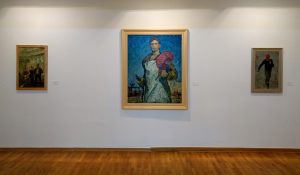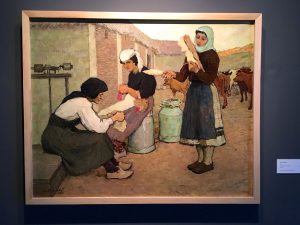Zef Shoshi’s collection of socialist realist art depicting everyday life during Enver Hoxha’s dictatorship is on display in Prishtina for the first time.
Although he is “an artist neither seeking nor attracted by fame,” in the words of exhibition curator Esmeralda Dalipi, painter Zef Shoshi is considered a national treasure in Albania.
Shoshi is also respected and internationally known for his depictions of life under communism in Albania, including his portraits of rural Albanian heritage. A time capsule derived from a half-century of continuous work offers an intimate insight into the artist’s stylistic direction that has remained consistent since the mid-1950s.
“Works 1956 – 2014” is Shoshi’s first exhibition in Kosovo, currently on display at the Kosovo National Gallery. The exhibition consists of 38 carefully selected pieces spatially distributed across the five gallery rooms, demonstrating the artist’s wealth of activity, ranging from oil paintings to ink drawings.

Assembly of Lezha, by Zef Shoshi (1978)
Each piece is a representation of Shoshi’s lifelong dedication to socialist realist art, presented against the backdrop of communist ideology and its subjects. Split within two periods, the exhibition showcases life under the communist regime and after.
Born in Tirana in 1939, shortly before the outbreak of WWII, Shoshi was educated at the “Ilya Repin” Institution in St. Petersburg, Russia, from 1957-1961. Eventually, upon his return to Albania, he graduated from the Tirana Institute of Arts.
“His father Pashko, a bank clerk, an amateur painter and art lover, also had an impact on Zef’s artistic formation during his childhood,” explained Ylli Drishti, another of the exhibition’s curators.
During his studies in Leningrad (now St. Petersburg), Shoshi was selected to study at Professor Boris Vladimirovich Johansson’s workshop, together with Sali Shijaku and Vilson Kilica.
Johansson, who lived in Moscow, “was one of the most important and renowned painters of Soviet socialist realism art,” said Drishti.
Having lived through the communist regime, Shoshi documented the communist ideology through art, with a prevalent focus on the people who toiled in the fields and factories. The working class was a prominent theme in Shoshi’s portrait and landscape pieces during and even after the fall of communism.

Photo courtesy of the Kosovo National Gallery.
Shoshi’s exhibition might be interesting to a Kosovar audience, especially since Yugoslav art was less restricted, explained art historian Vesa Sahatciu.
“In Yugoslavia the art scene was very different. There wasn’t socialist realism, there was an idea of modernity and experimentation,” said Sahatciu.
Sahatciu further added that in Albania until the mid ‘90s, the opposite was apparent. She said that in Albania “the subject matter was very important…and only Leftist-Marxist [paintings] were allowed.” Albanian painters who were considered too expressive were jailed, said Sahatciu.
“The countryside was the perfect setting, the idea of the perfect man relates to the peasantry, the working class. They were not allowed to process things beyond the ideology of that time. To have agency of your own was very dangerous. Shoshi was very much a proponent of that ideology,” said Sahatciu.
Shoshi spent a considerable amount of time painting the Zadrima region’s inhabitants, documenting the region’s rich traditional and cultural heritage that existed and survived within the constraints of the socio-political climate.
According to Dalipi, the human form and Albanian life became a prominent theme as an escape from the constraints imposed during the dictatorial period.
Dalipi also believes that Shoshi’s diverse collection of work is of great importance to Albania’s political and historical past. Shoshi’s works, the tableaux of leaders of the National-Liberation War, including the defining 1974 portrait of Enver Hoxha, have amassed an unprecedented esteem in Albania for their historical and documentary value.
“Shoshi has, in his creativity, produced a considerable number of compositions of historical events and political portraits, but also works in which special attention is paid to Zadrima inhabitants’ traditional and cultural elements of daily life,” said Dalipi.

“Dairymaids” (1962) – Oil on canvas. Photo: Genta Dushi
From oil paintings to ink drawings, the exhibition demonstrates the painter’s technical achievement. The rich use of color, as seen in the oil portrait of a young woman titled “From Zadrima” (1961) and an oil painting of writer Shefqet Musaraj (1976) are examples of Shoshi’s distinct style and contribution to the collective memory of Albanian life.
“What distinguishes Mr. Shoshi’s work amongst his peers is the continued elegance, precision, and an element of coherence that is transparent throughout his work, a realistic spirit that is not as evident in other artists of that generation,” said Dalipi.
The exhibition “Works 1956 – 2014” is running until April 30 at the National Gallery of Kosovo. Opening hours are Tuesday – Friday, 10:00 am – 6:00 pm, and Saturday – Sunday 10:00 am – 5:00 pm.





